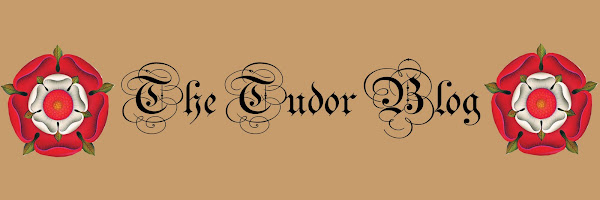
On
August 8, 1503, Princess Margaret of England, eldest daughter of King Henry VII and Elizabeth of York, travels north and officially marries James IV of Scotland at Holyrood Abbey in Edinburgh. Margaret had actually been considered queen consort since the Treaty of Perpetual Peace was signed and she was married by proxy in 1502.
The couple would have six children, although only one would live past infancy and become King James V. King James IV died at the hands of her brother's army at the Battle of Flodden in 1513, leaving Margaret as a pregnant Dowager Queen of Scots, Regent for her sons, and a not very seasoned or clever stateswoman. (She remarried quickly, removing her from power.) Margaret married Archibald Douglas, 6th Earl of Angus (known by his own kin as "witless") and by him had a daughter, Lady Margaret Douglas (future countess of Lennox and mother of Henry Stuart, Lord Darnley - future husband of Mary, Queen of Scots). The pair had fled to England, but Angus soon abandoned his wife and returned to Scotland to live with his mistress. Margaret was able to obtain a divorce from the Pope, but was (ironically) heavily criticized by her brother, Henry VIII. Margaret moved on to husband number 3, Henry Stuart, Lord Methven and both became advisors to her son, King James V.
Despite being the elder sister of King Henry VIII, Margaret's children were originally eliminated from the line of succession to the throne of England by Henry VIII. However, when the Tudor Dynasty died with a childless Elizabeth I, the English throne passed through Margaret's heirs. Her great-grandson, James VI of Scotland, became James I of England, thus uniting the crowns of the two countries and conferring on Margaret something of a posthumous triumph.
Also on
August 8, 1588, the Royal Navy of Queen Elizabeth I drove the Spanish Armada from the Strait of Dover in the Battle of Gravelines, forcing them to head home. Troops were still held at ready in case the Spanish army of the Duke of Parma might yet attempt to invade from Dunkirk.
.jpg)
On 8 August Old Style (18 August New Style), the Queen left her bodyguard before the fort at Tilbury and went among her subjects, with an escort of six men, in white with a silver cuirass and mounted on a grey gelding. She was flanked on horseback by her Lieutenant General the Earl of Leicester on the right, and on the left by the Earl of Essex, her Master of the Horse.
She gave to them what is probably her most famous speech:
"My loving people, we have been persuaded by some that we are careful of our safety, to take heed how we commit ourselves to armed multitudes for fear of treachery; but, I do assure you, I do not desire to live to distrust my faithful and loving people. Let tyrants fear, I have always so behaved myself, that under God I have placed my chiefest strength and safeguard in the loyal hearts and goodwill of my subjects; and, therefore, I am come amongst you as you see at this time, not for my recreation and disport, but being resolved, in the midst and heat of battle, to live or die amongst you all — to lay down for my God, and for my kingdoms, and for my people, my honour and my blood even in the dust. I know I have the body of a weak and feeble woman; but I have the heart and stomach of a king — and of a king of England too, and think foul scorn that Parma or Spain, or any prince of Europe, should dare to invade the borders of my realm; to which, rather than any dishonour should grow by me, I myself will take up arms — I myself will be your general, judge, and rewarder of every one of your virtues in the field. I know already, for your forwardness, you have deserved rewards and crowns, and, we do assure you, on the word of a prince, they shall be duly paid you."
 "The Tudors" and actress Natalie Dormer were nominated for several Gemini Awards by Canada's Cinema and Television Academy. While I would still prefer to have seen Natalie get the nod for awards here or in the UK, I am thrilled someone will acknowledge her incredible performance as Anne Boleyn in season two of The Tudors.
"The Tudors" and actress Natalie Dormer were nominated for several Gemini Awards by Canada's Cinema and Television Academy. While I would still prefer to have seen Natalie get the nod for awards here or in the UK, I am thrilled someone will acknowledge her incredible performance as Anne Boleyn in season two of The Tudors.





.jpg)